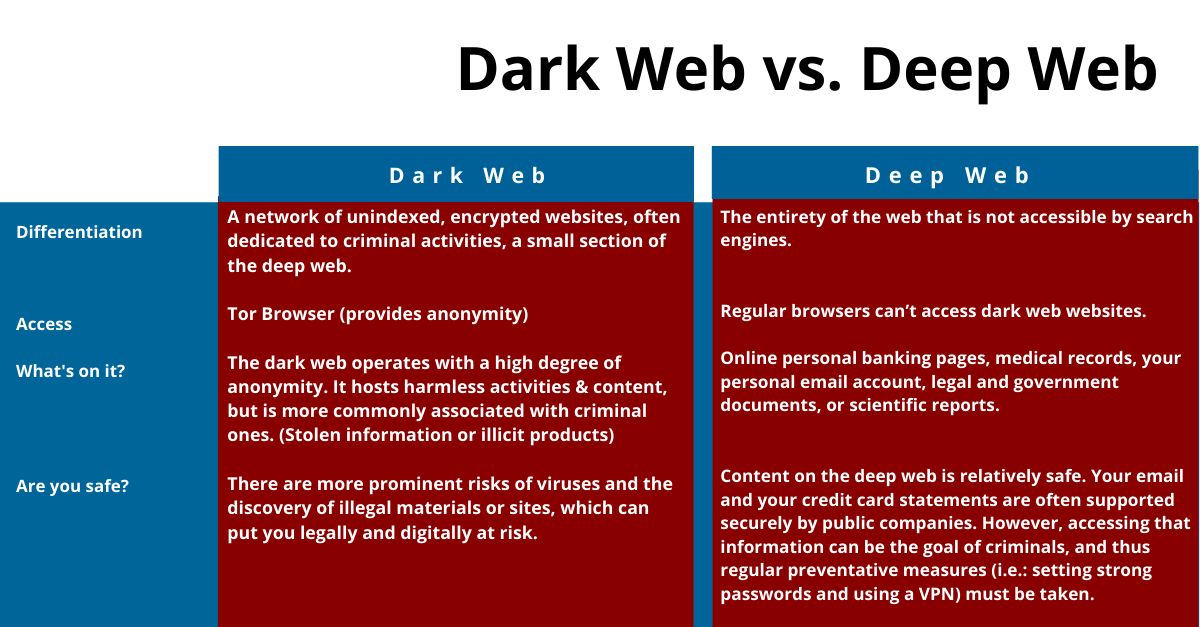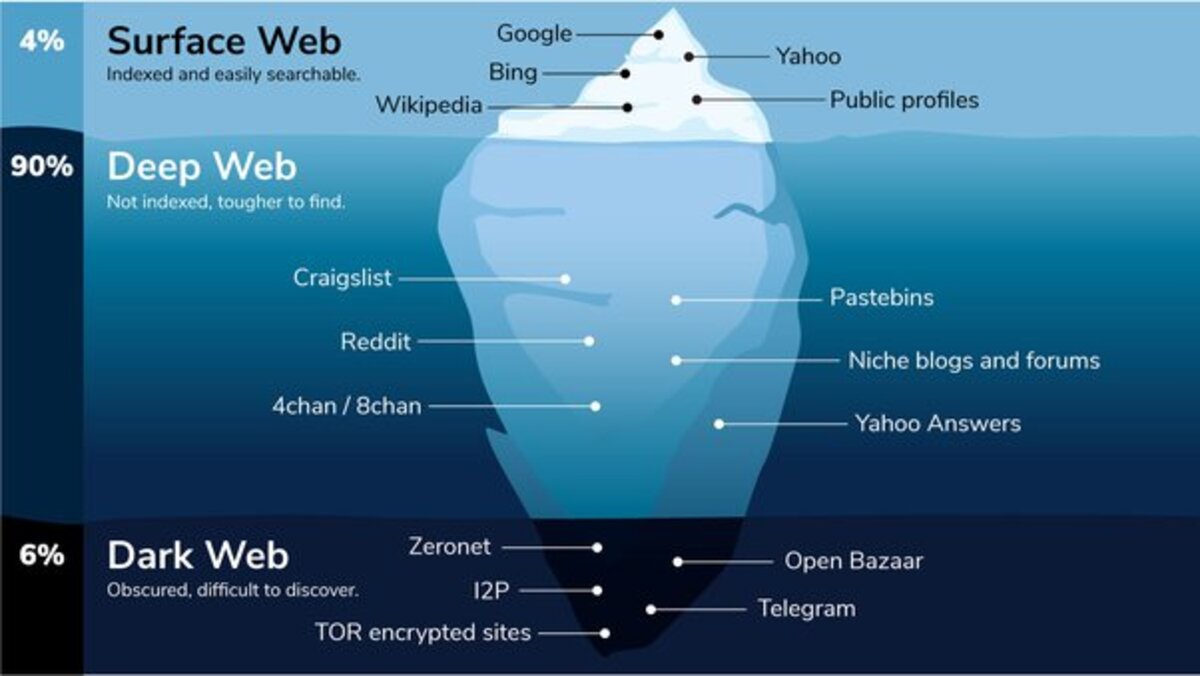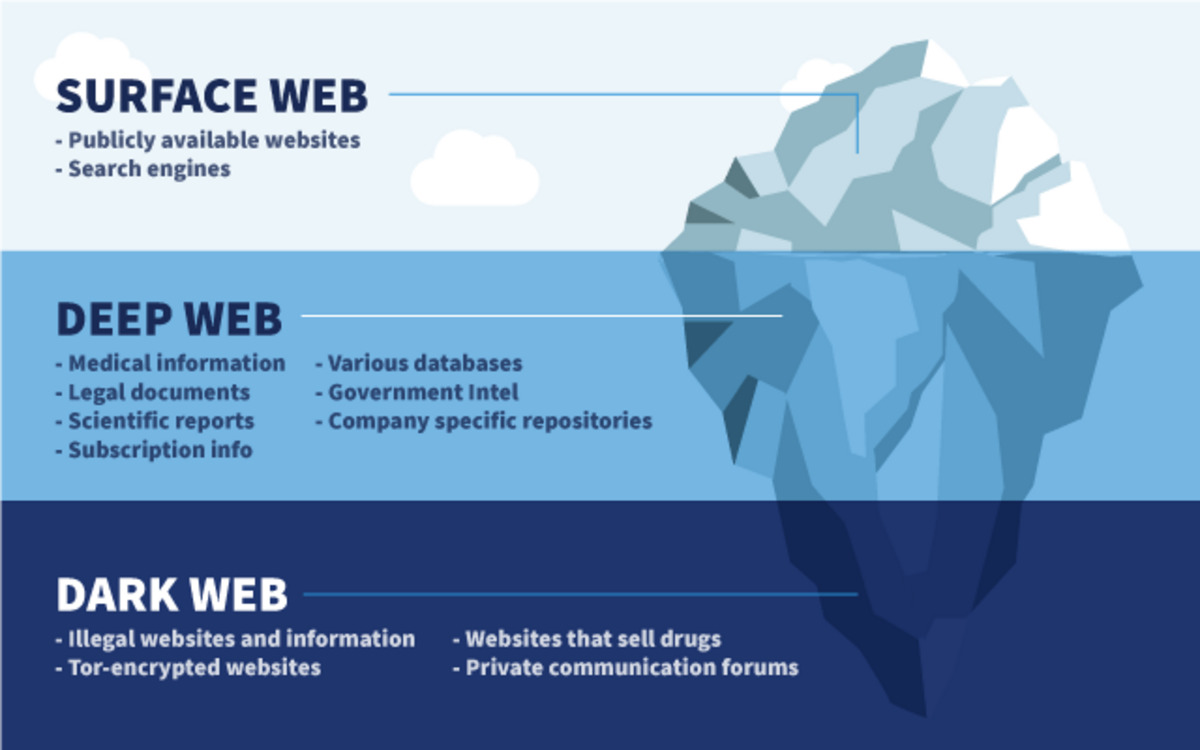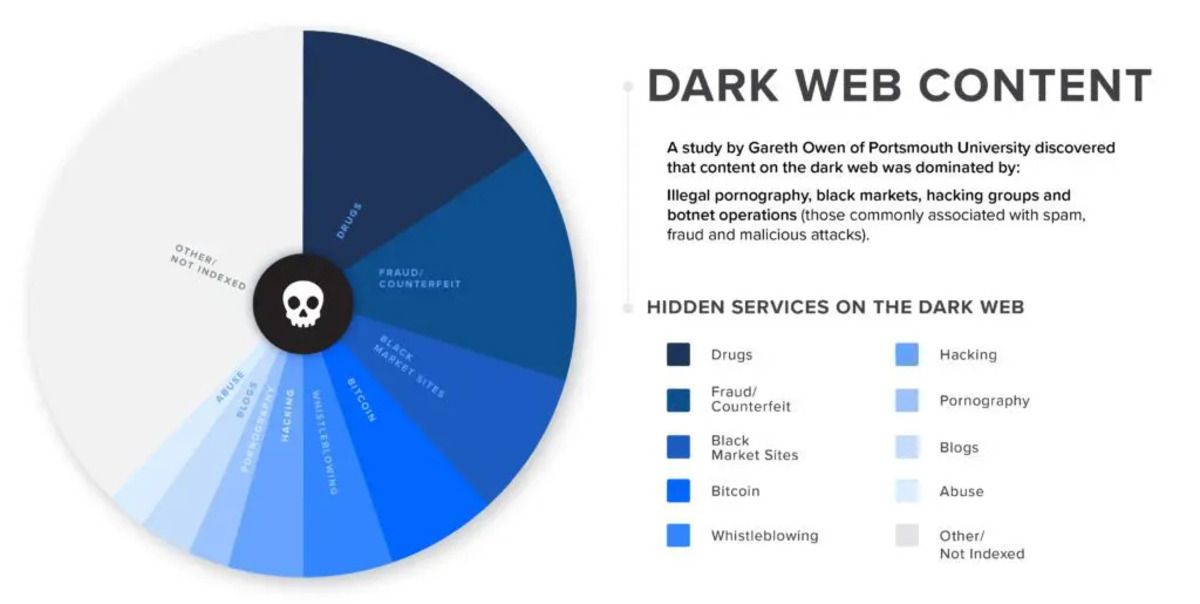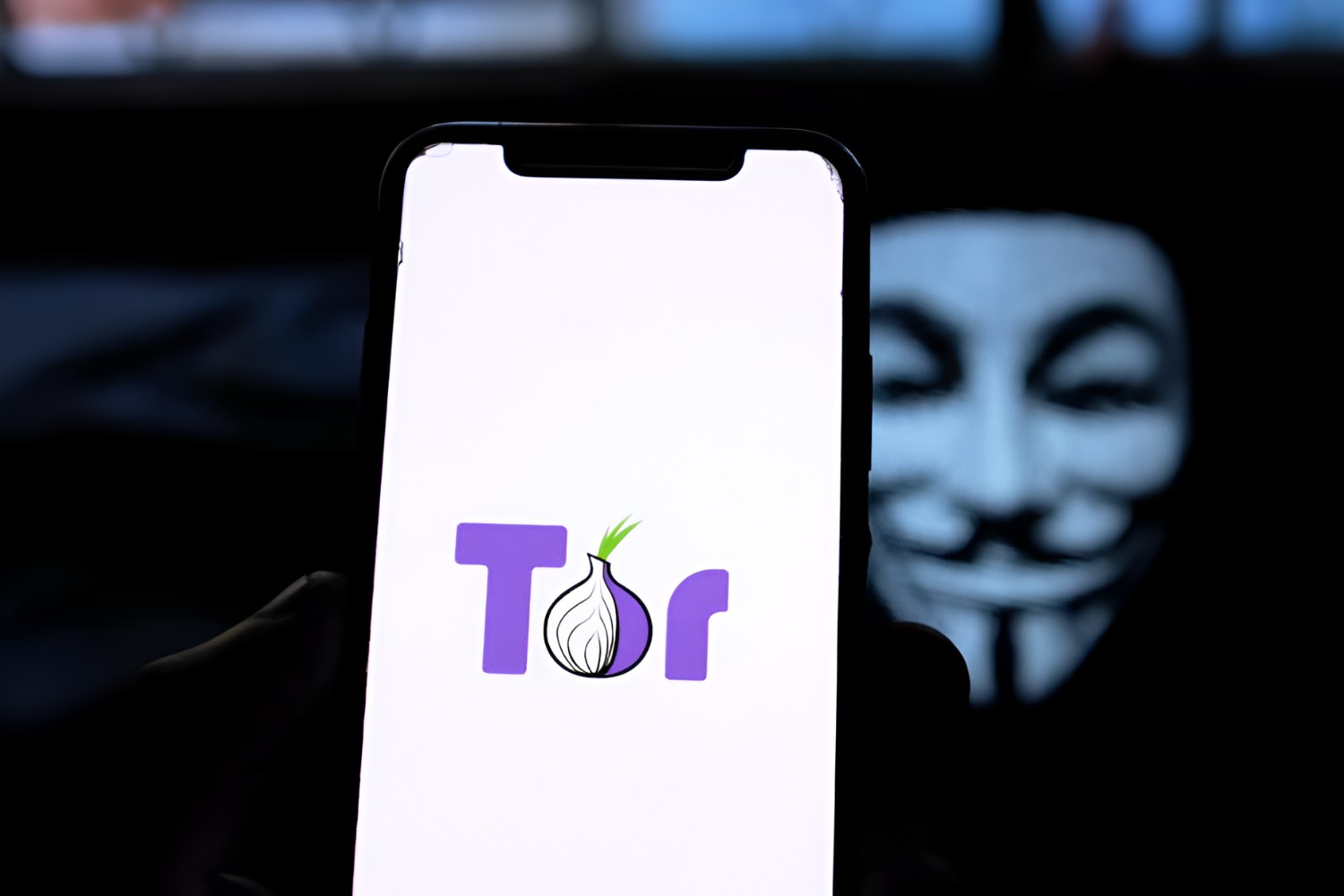Introduction
The internet is a vast ecosystem comprising numerous layers, with the surface web being the most commonly accessed and visible part. However, beneath the surface lies a deeper and lesser-known realm called the deep web. In recent years, another secretive part, known as the dark web, has gained considerable attention. While these terms are often used interchangeably, they actually refer to distinct aspects of the internet.
The deep web primarily consists of websites and content that are not indexed by search engines, making them inaccessible through traditional search methods. It includes private databases, academic repositories, subscription sites, and other online resources that require special access permissions. On the other hand, the dark web is a subset of the deep web that is intentionally concealed and accessible only through specific software and encrypted networks.
Understanding the differences between the deep web and dark web is essential for grasping the intricacies of the internet landscape. In this article, we will delve into the characteristics, purposes, and contrasting features of these two hidden layers. We will also discuss the risks and precautions associated with venturing into the dark web, emphasizing the importance of online security.
Understanding the Deep Web
The deep web is often shrouded in mystery, but it is an integral part of the internet that houses a vast amount of content. Unlike the surface web, which is easily accessible and indexed by search engines like Google, the deep web is not readily visible to the average internet user. This hidden portion consists of websites and databases that are protected by passwords, paywalls, or restricted access.
One of the primary reasons for content residing in the deep web is the need for privacy and security. Organizations and institutions, such as government agencies, academic institutions, and corporations, often store sensitive information that is not meant for public consumption. This can include classified documents, research databases, financial records, and personal user information.
Additionally, the deep web encompasses subscription-based services, online shopping sites that require logins, and other platforms that demand user authentication. These websites create barriers to entry in order to protect proprietary content or maintain exclusivity for paid members.
It is important to note that not all content on the deep web is sinister or illegal. While it does host some illicit activities, the deep web is predominantly a repository of legitimate resources that cater to specialized fields, such as scholarly research, data analysis, and professional networking. Researchers, journalists, and academics often utilize the deep web to access valuable information that is not accessible through mainstream search engines.
Exploring the Dark Web
If the deep web is the hidden part of the internet, then the dark web is like its underworld, filled with intrigue and illicit activities. The dark web is a subset of the deep web that is intentionally hidden and requires specific software, such as Tor (The Onion Router), to access. This software ensures anonymity by encrypting users’ data and bouncing it through multiple servers, making it difficult for anyone to trace their online activities.
The dark web is home to a plethora of anonymous websites and online marketplaces where users can engage in various activities. These activities include the sale and purchase of illegal drugs, weapons, stolen data, counterfeit currencies, and hacker tools. Alongside these cybercriminal marketplaces, there are forums and chat rooms where individuals can anonymously discuss and share information related to hacking, cybercrime, and other unlawful activities.
However, it is important to emphasize that not everything on the dark web is illegal. While it has gained notoriety for its criminal elements, there are also legitimate uses for the dark web. For example, the dark web provides a platform for activists, journalists, and whistleblowers to communicate securely and exchange sensitive information without fear of censorship or surveillance.
Exploring the dark web comes with significant risks. Due to its nature, it attracts cybercriminals, scammers, and hackers looking to exploit unsuspecting visitors. Users may unknowingly stumble upon malicious websites or fall victim to scams, resulting in compromised personal information, financial loss, or even legal consequences.
It is important to exercise extreme caution and take cybersecurity measures when venturing into the dark web. This includes using a reliable and updated antivirus software, virtual private networks (VPNs) for added security, and Tor browser settings that ensure maximum anonymity. By taking these precautions, users can minimize the risks associated with exploring the dark web and preserve their online safety.
Key Differences between the Deep Web and Dark Web
While the terms “deep web” and “dark web” are often used interchangeably, they actually represent distinct aspects of the internet with significant differences. Understanding these differences is crucial for navigating the complexities of the hidden web. Here are the key distinctions between the deep web and dark web:
- Accessibility: The deep web refers to all web content that is not indexed by search engines, making it inaccessible through traditional search methods. In contrast, the dark web is a subset of the deep web that is intentionally concealed and requires specific software, like Tor, to access its hidden websites and services.
- Visibility: While the deep web is hidden from search engines, some content can still be accessed with proper authorization or by following specific links. On the other hand, the dark web is intentionally made inaccessible and requires deliberate actions, such as using software and networks, to access its content.
- Content: The deep web consists of a wide range of legitimate and legal content, including private databases, academic resources, subscription sites, and more. It is vast and diverse, catering to individuals and organizations with specific access permissions. In contrast, the dark web predominantly houses illicit activities, illegal marketplaces, forums for hacking and cybercrime, and other illegal content.
- Anonymity: While the deep web does provide some level of privacy due to its restricted access, it does not offer the same level of anonymity as the dark web. The dark web ensures anonymity through encrypted networks and software like Tor, making it difficult for users to be traced or identified.
- Risks: While there are risks associated with exploring both the deep web and dark web, the dark web poses significantly higher risks due to its criminal activities and the presence of malicious actors. Venturing into the dark web without proper precautions can expose individuals to scams, cyber attacks, and legal consequences.
By understanding these key differences, users can have a clearer understanding of what the deep web and dark web entail and make informed decisions about their online activities and safety.
Anonymity and Security in the Dark Web
One of the defining features of the dark web is the anonymity it provides to its users. The use of specialized software like Tor, along with encrypted networks, helps conceal the identity and location of individuals accessing the dark web. This anonymity is crucial for individuals who wish to exercise their freedom of speech, engage in whistleblowing activities, or communicate securely in oppressive regimes where internet surveillance is prevalent.
However, it is important to recognize that the anonymity offered by the dark web is a double-edged sword. While it can protect the privacy of users, it also creates an environment that attracts cybercriminals and facilitates illegal activities. This includes the sale of drugs, weapons, stolen data, and other illicit goods and services. The anonymity and encryption protocols in place make it challenging for law enforcement agencies to identify and apprehend those involved in criminal activities on the dark web.
Although the dark web offers a certain level of anonymity, it does not guarantee absolute security. Users must be diligent in taking extra precautions to safeguard their online activities and personal information. This includes:
- Using a Virtual Private Network (VPN): A VPN helps mask your IP address and encrypts your internet connection, providing an additional layer of anonymity and security when accessing the dark web.
- Ensuring Tor Browser Security: Staying up to date with the latest version of the Tor browser and configuring the privacy settings correctly can help prevent any potential vulnerabilities and protect against security breaches.
- Avoiding Personal Information: It is crucial to refrain from sharing personal information, such as real names, addresses, or financial details on the dark web. This reduces the risk of identity theft, scams, and other cybercrimes.
- Being Wary of Malicious Content: The dark web is notorious for hosting malicious websites and malware. Users must exercise caution and avoid clicking on suspicious links or downloading unknown files to prevent their devices from being compromised.
- Keeping Antivirus Software Updated: Regularly updating antivirus software and running scans can help detect and mitigate potential threats on the dark web.
While anonymity is provided in the dark web, it is essential to understand the risks and take proactive measures to ensure online security. By following these precautions, users can navigate the dark web more securely and protect their personal information from falling into the wrong hands.
Illegal Activities on the Dark Web
The dark web has gained notoriety for its association with various illegal activities. Due to its anonymity and encryption features, the dark web has become a hub for criminal enterprises and illicit transactions. While it is important to highlight that not all activities on the dark web are illegal, there are significant risks associated with engaging in or encountering illegal activities. Here are some of the common illegal activities found on the dark web:
- Illegal Drug Trade: The dark web is infamous for its underground marketplaces where individuals can buy and sell illegal drugs. These marketplaces operate with hidden identities and cryptocurrencies as payment, making it challenging for law enforcement to track these activities.
- Weapons and Arms Trafficking: The dark web provides a platform for individuals to purchase firearms, explosives, and other illegal weapons. These transactions occur discreetly, enabling individuals to acquire potentially dangerous weapons without detection.
- Identity Theft and Fraudulent Activities: The dark web hosts various forums and marketplaces that trade in stolen personal information, including credit card details, social security numbers, and login credentials. This information is often used for identity theft and fraudulent activities.
- Hacking and Cybercrime: The dark web is a haven for hackers and cybercriminals, offering resources and forums for the exchange of hacking techniques, malware, and stolen data. This fuels cyber attacks, ransomware campaigns, and other malicious activities.
- Illegal Pornography and Exploitation: The dark web contains hidden websites that cater to illegal pornography, child exploitation, and other highly unethical and criminal activities. These websites operate far from the reach of law enforcement, facilitating their continuation.
It is important to understand the risks associated with encountering these illegal activities on the dark web. Engaging in any illegal activities can lead to severe legal consequences. In addition to the legal risks, users may also be targeted by scams, malware, and other cyber threats while navigating the dark web. Therefore, it is crucial to exercise extreme caution, avoid engaging in illegal activities, and prioritize personal safety and security when exploring this hidden part of the internet.
Accessing the Deep Web and Dark Web Safely
Exploring the deep web and dark web can be intriguing, but it also comes with significant risks. To navigate these hidden parts of the internet safely, it is essential to take the following precautions:
- Use Reliable Software: When accessing the deep web or dark web, use trusted and secure software such as the Tor browser. This software ensures anonymity and encrypts your data, reducing the risk of surveillance and tracking.
- Protect Your Identity: It is vital to safeguard your identity while accessing the deep web or dark web. Avoid using any personal information, such as real names or personal email addresses, that can be traced back to you. Creating a separate, anonymous identity can further enhance your privacy and security.
- Employ VPNs and Proxies: Virtual Private Networks (VPNs) and proxies provide an extra layer of security by masking your IP address and encrypting your internet connection. This helps protect your identity and adds another barrier between your online activity and potential threats.
- Stay Updated and Use Security Measures: Keep your software and antivirus programs up to date to defend against potential vulnerabilities. Enable firewalls, anti-malware software, and other security measures to protect your device from any potential threats encountered on the deep web or dark web.
- Avoid Suspicious Links and Downloads: Be cautious when clicking on links or downloading files from the deep web or dark web. Malicious websites and files can be disguised as innocent or desirable content. Always be aware of potential risks and verify the trustworthiness of sources before engaging.
- Minimize Interaction: While exploring the deep web or dark web, it is advisable to limit your interactions with unknown or suspicious individuals. Engaging in conversations or transactions with unknown parties can expose you to scams, hacking attempts, or other harmful activities.
- Protect Your Finances: Avoid providing any financial information, such as credit card details or bank account numbers, on the deep web or dark web. Cryptocurrencies like Bitcoin are commonly used for transactions, but exercise caution and conduct thorough research on reputable and secure payment methods.
These precautions are essential in ensuring your safety and security while accessing the deep web or dark web. It is important to remember that navigating these hidden parts of the internet is not without risks, and it requires a conscious effort to protect yourself from potential threats.
Conclusion
The deep web and dark web are fascinating yet enigmatic parts of the internet that hold considerable intrigue for many. Understanding the differences between these hidden layers is crucial for navigating and exploring them safely. While the deep web encompasses a vast array of legitimate content that is not indexed by search engines, the dark web represents a more secretive subset with a focus on illicit activities and anonymity.
It is important to approach the deep web and dark web with caution and a thorough understanding of the risks involved. While the deep web hosts valuable resources and legitimate content, it still requires adherence to privacy and legal guidelines. Additionally, venturing into the dark web requires even greater precaution due to its association with illegal activities and malicious actors.
To access the deep web and dark web safely, users should prioritize their online security. This involves utilizing trusted software like Tor, employing virtual private networks (VPNs), updating security measures, and avoiding suspicious links and downloads. It is crucial to protect personal information, be mindful of potential scams, and exercise discernment when interacting with others.
While the deep web and dark web offer opportunities for privacy, freedom of speech, and accessing specialized content, it is important to remember that illegal activities and potential risks exist within these hidden realms. Users must evaluate the benefits and drawbacks, always prioritize personal safety, and ensure compliance with legal and ethical guidelines.
By understanding the nuances of the deep web and dark web and taking adequate precautions, individuals can navigate these hidden layers of the internet with greater confidence and minimize potential risks to their online security and well-being.







